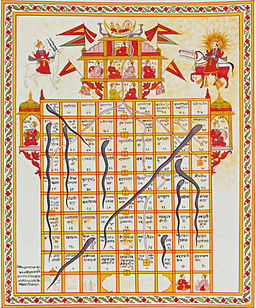Moksha Patam, or ‘Snakes and Ladders’, as it is known in English, gained popularity in the West in the 20th Century, having originated in Bharat as part of a family of dice board games, along with Gyan chauper and pachisi (present-day Ludo and Parcheesi). The game has a strong association with traditional Hindu philosophy contrasting karma (the law of action and reaction) and kama (material desire).
The ladders represent good virtues such as selflessness, humility and faith; while snakes represent vices like anger, murder, stealing and lust. The premise of the game is that only by performing good deeds, we are able to attain Moksha, while evil actions will lead to descending into lower births and, in some cases, even starting again from square one. Attainment of Moksha is the ultimate goal of all life forms, as it allows us to escape the tiresome cycle of death and rebirth, or in the case of Moksha Patam, is victory.
There are more snakes than there are ladders, being symbolic that it’s harder to to the right thing than it is to succumb to the temptation to sin.
- Devdutt Pattanaik (2007): “Playing with fate and free will”.

